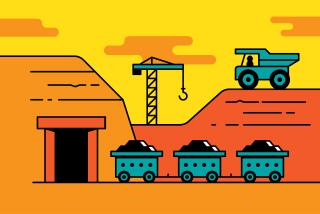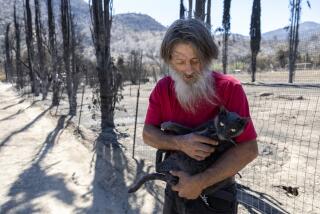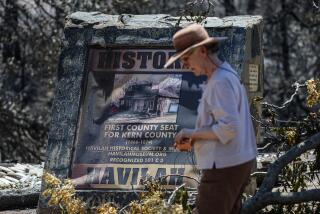A labor dispute threatens to tear a Kern County mining town apart
Reporting from Boron, Calif. â For more than half a century F.O. Roe, a former Army drill instructor with a steady gaze and a poker face, has watched the fortunes of this sun-blasted town ebb and flow.
Heâs seen the 58 Freeway bypass and isolate the community, the steady exodus of the young as they seek their fortunes elsewhere and the increase in crime he attributes to newcomers from Los Angeles.
Each blow has staggered the Kern County town, but none has knocked it off its feet -- until perhaps now.
âI think if the cards are not played right on this, it could be what breaks the back of this little town and kills it,â he said, as he sipped coffee in the back room of the Emporium, his general store.
A shadow has fallen over this close-knit community of 2,000 as fears deepen of a strike at the borax mine on the cityâs edge.
âThe whole town is tied to that mine. Most of the people who live here now work at the plant,â said David Liebengood, president of International Longshore and Warehouse Union Local 30, which represents the employees. âIt has passed through generations.â
But the days of generational job security may be over. Citing a 25% loss in its share of the global market, mining company Rio Tinto has spent the last five months trying and mostly failing to extract concessions from the union, including changes in the cherished seniority system.
The company now has threatened to lock out its roughly 600 hourly employees and bus in replacements as early as this morning.
Workers say itâs all a thinly veiled attempt to break the union.
âIâm 55 and have been here for 32 years, and suddenly I feel like I have no security,â said Larry Roberts. âIf I knew this would happen, I wouldnât have come here in the first place.â
Borax is to Boron what automobiles are to Detroit. The homely, grayish mineral is a key ingredient in just about everything -- detergent, surfboards, plasma televisions (it strengthens the glass screens).
It was once hauled out of Death Valley by mule. But when borax was discovered here in 1925, job seekers arrived from around the country, and built homes from rocks and empty ammunition cans -- whatever they could scrounge from the desert.
Barbara Pratt, 89, is director of the Twenty Mule Team Museum, a shrine to all things borax. She moved here at age 12 and lived in a yellow boxcar.
âWe had to carve out the windows ourselves,â she said, as she stacked little bags of borax in the museum gift shop, which has a wall devoted to Julia Roberts because parts of âErin Brockovichâ were filmed here.
Early on, town and mine became inseparable.
For any man willing to move his family to this harsh outpost about 30 miles from Mojave, the company offered a job for keeps.
âYou had to really want to get fired,â said retired mine worker Bob Emrich.
Itâs that bond between mine and town that makes the current tensions so hard for miners to accept.
The company once financed Little League teams, a public swimming pool, local museums. Managers, who now tend to commute from Palmdale and Lancaster, once lived alongside hourly workers.
âIt was a good company town. We were all a big family,â said Terry Dill, a former miner, as he ate breakfast recently at the K & L Corral diner. âSome of the women didnât like it at first because there was nothing to do, no place to shop and we were in the middle of nowhere. But the pay was good and once you got a job here, you had it for life.â
Cracks in the relationship appeared during a 1974 strike, marked by rowdy pickets and some violence.
âThe strike was like a civil war. It turned father against son, salaried workers versus those with hourly pay,â recalled Dill, who found a job during the strike at a mine in Mountain Pass.
âI bet 50% of people moved out of town after 1974,â he said. âIt really hurt us.â
The townâs population has been dwindling ever since.
âFive years ago we had 290 students, and now itâs 127,â said Robert Kostopoulos, a teacher and assistant football coach at Boron High School, who comes from a long line of miners, back to his great-grandfather.
âThe money the company makes is unbelievable. They know they could fill those jobs in a minute if there was a strike,â he said. âAt the end of the day, I donât think they care.â
That seems to be the prevalent view. Signs all over town say, âWe support the Borax miners. An injury to one is an injury to all.â
One hangs in the window of Domingoâs Mexican restaurant, an island of frenetic activity on the sleepy commercial drag. Locals say the business is so popular that patrons drop in from outer space, which is true. The place is a favorite of shuttle astronauts landing at nearby Edwards Air Force Base, who sometimes e-mail lunch orders before touching down.
Inside, sombreros, strands of plastic fish and a cigar-store Indian compete for space with autographed posters of military aircraft and astronauts. A toy train hauling borax and a toy shuttle chugs just below the ceiling.
Owner Domingo Gutierrez introduces himself as the mayor of Boron and signs posters of himself that way too. Heâs actually the honorary mayor, a title Boron bestows on the citizen who raises the most money for charity.
âNobody wins if we donât compromise,â Gutierrez said of the mine dispute. âThere is too much at stake.â
Heâs lived in Boron since 1988.
âI have three kids growing up here. My roots are in Boron. This is where I became successful,â he said. âThere are no gangs. You can keep track of your kids. Boron is like any other place -- what you plant is what you harvest.â
A few miles away at Rio Tintoâs mine, the harvest is borax and more borax. The operation on Borax Road is the second-biggest borax mine on Earth and the largest open-pit mine in California.
On a recent afternoon, workers piloted yellow trucks taller than most houses -- each able to carry 240 tons of borax. Bags of borax were stacked inside massive silos. Blasts of steam erupted from pipes while conveyor belts sped processed borax to waiting rail cars.
Rio Tinto employs some 720 people in Boron, paying $12 to $35 an hour. The London-based mining giant operates on five continents and reported $2.5 billion in net earnings for the first half of 2009, down 65% from the same period in 2008.
Robert Deal, the mineâs director of research and development, has worked here for 29 years.
âWe want to see Boron survive, but we want to work with them as a partner and not as a company town,â he said, looking at the mile-wide, 900-foot-deep gash in the Earthâs crust.
âItâs not the old company town we had in the past. There was a time when you assumed your kids and their kids would grow up and work in the mine. But more of the youth in Boron are moving away.â
General Manager Dean Gehring, who took over two months ago, said big changes are needed to stay competitive.
Promotions now are entirely based on seniority, he said, and qualifications need to be taken into account.
Gehring insists he has no interest in breaking the union but said the threat of a strike is very real.
âWe could fill the jobs overnight, but we donât want to do that. We want to use the people we have,â he said. âItâs easy to cast this as a David versus Goliath thing, but we are really in this together.â
On a cold, windy night last month, hundreds of residents and miners showed up at the union hall, about a mile down the road from the mine.
Despite balloons, doughnuts and defiant posters, the bonhomie felt a bit forced. The anxiety was too deep.
Emotions spilled over.
Kayla Martz, a stay-at-home mom, said that her husband will earn $55,000 this year at the mine but that it seems the company wants âto take from him and give the money to the top executives and shareholders who make millions.â
âWe are not just cogs in a machine. We are families, and we have names,â she told the hushed crowd.
Roe, the shopkeeper, was there too. Heâs lived in Boron for 52 years, serving on school boards and commissions and as president of the local chamber of commerce. Heâs also a former union leader at the mine.
âThis is your life,â he told the gathering. âAnd the lives of everyone around you.â
As the sun slipped behind the mountains, people began marching toward the mine. Men with flashlights led the way, forming long silhouettes against an indigo twilight of desert and Joshua trees.
Outside the gates, they lighted candles and shouted, âWhat do we want? A contract! When do we want it? Now!â
As they huddled in the dark, under the watchful eyes of company guards, a sense of quiet solidarity took hold.
Still, Rose Fowlkes felt unsettled. A minerâs wife and a mother of four, sheâs a recent arrival who had hoped to put down real roots.
âItâs a very scary time. We just moved here and bought a house, and now they are talking about changing things,â she said, pulling her 6-year-old daughter, Savana, close. âThe biggest fear is just not knowing.â
More to Read
Inside the business of entertainment
The Wide Shot brings you news, analysis and insights on everything from streaming wars to production â and what it all means for the future.
You may occasionally receive promotional content from the Los Angeles Times.










